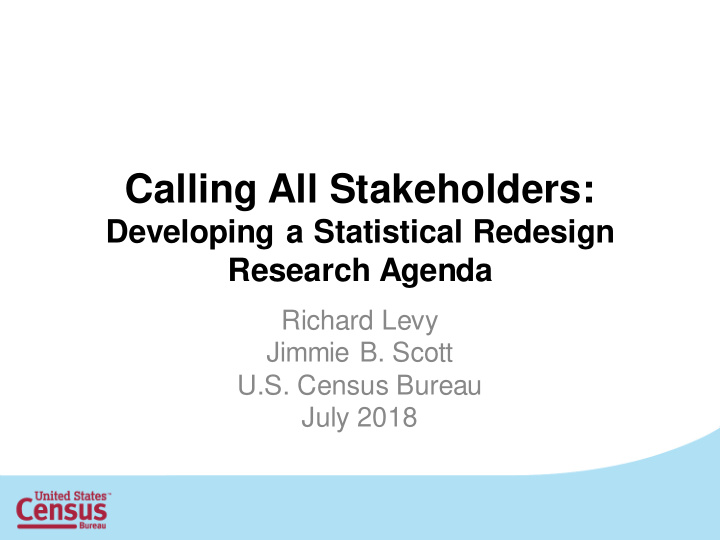



Calling All Stakeholders: Developing a Statistical Redesign Research Agenda Richard Levy Jimmie B. Scott U.S. Census Bureau July 2018
Disclaimer Any views expressed are those of the authors and not necessarily those of the U.S. Census Bureau. 2
Overview • What is Redesign? – History – Scope • Developing the Redesign Agenda – Challenges – Opportunities – Building the agenda • Lessons and suggestions for redesign efforts 3
Why redesign? • Sample adjustment • Innovations (statistical methods, technology) • Research • Evaluation 4
Redesign History • Began in 1940s – sample survey of unemployment • Historically tied to each census • Redesigns updated frame development, business, and sampling processes – e.g., Automated listing, oversampling • Most recent redesign eliminated two expensive frames 5
Redesign – Current Scope Five major demographic surveys: Survey Sponsor American Housing Housing and Urban Development Consumer Expenditures Bureau of Labor Statistics Current Population Bureau of Labor Statistics Income and Program Participation Direct Congressional appropriation National Crime Victimization Bureau of Justice Statistics 6
Survey characteristics Each survey has unique: • Purposes • Sponsor • Design (rotating panel versus longitudinal) • Periodicity • Key estimates Challenge to Research and Develop Common Innovations Across Surveys 7
Redesign -- Scope • Survey design • Frame development • Sample design • Estimation • Data collection (instrument, response strategies) • Quality and quality measures 8
Developing the Redesign Agenda – External Challenges and Opportunities • Budget constraints • Declining response rates • Alternative data sources • Confidentiality and privacy concerns 9
Developing the Redesign Agenda – Internal Challenges and Opportunities • Innovation versus continuity of estimates • New technology and methods – Move towards enterprise solutions • Balancing statistical design with workforce constraints 10
Building the Redesign Agenda • Identified stakeholders • Solicited ideas from: – All affected supervisory (mathematical) statisticians within division sponsoring redesign – Survey director teams – Sponsors as directed by survey director teams – Participants in prior Redesign • Customized approach for each survey team 11
Building the Redesign Agenda • Gathered ideas for projects and for processes (i.e., lessons learned) • Documented ideas • Verified and shared ideas with stakeholders • Prioritized initial research ideas based on merit, cost, and feasibility • Shared results of prioritization with stakeholders • Began work! 12
Determining the Redesign Vision • Conducted a kickoff visioning meeting with a range of stakeholders • Conducted subsequent brainstorming meetings with division experts on topics identified in kickoff • Met with stakeholders and potential partners across the bureau • No clear vision emerged, as of yet…a vision in progress 13
Selected Redesign Projects • Alternate methods for stratifying primary sampling units in first-stage of two-stage sample design • Determining optimal first- and second- stage sample sizes • One-stage sample design? • Developing customized frames • Measuring and quantifying response error 14
Lessons to Share • Build administrative infrastructure, even if provisional (infrastructure is always in progress, anyway) • Engagement – Identify and include all participants, and keep updated • Reach out to those engaged in similar or complementary efforts • Build consensus – seek first to understand – Acknowledge areas of disagreement 15
Future Directions • Conduct sample-based research within division • Collaborate across divisions and agencies on areas of interest (addressing survey nonresponse, measuring total survey error, using supplemental data) • Revise or develop new samples • Continue to grow the redesign research agenda 16
Questions? 17
Contact Richard Levy Redesign Program Manager 301-763-4553 richard.a.levy@census.gov 18
Recommend
More recommend